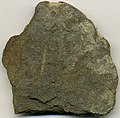List of minerals named Tasmanite
Appearance
Tasmanite (in the narrow sense of the word: found in Tasmania) — a polysemantic term from the field of geology and mineralogy. The term originally appeared in 1864-1865, when Professor A. H. Church carried out a series of studies in several oil shale deposits on the banks and in the vicinity of the Mersey River (northern Tasmania), collected samples and made analyzes, based on the results of which the sedimentary rock was first described called tasmanite,[1]: 92 and a year later the mineral of the same name appeared.[2]: 317
Basic minerals and rocks
- Tasmanite or tasmanian australites are a regional Tasmanian form of australites,[3]: 12 the most common type of tektite, a glass of meteoritic origin, traditionally named after its geographic location.
- Tasmanite or tasmanian black glasses is the main name by which Darwin glass, tektite-impactite, discovered in the southwest of Tasmania, was known until the mid-1970s.[4]
- Tasmanite is a sedimentary rock, a marine oil shale,[5] mainly composed of the fossilized single-celled green algae Tasmanites. Found predominantly in southern Tasmania in coastal areas.[1]: 92
- Tasmanite or «tasmanian amber» is one of the local names for a red-brown translucent mineral, described in 1865,[6]: 376 similar to amber.[7]: 193
- Tasmanites (Latin: Tasmanites; Newton, 1875), sometimes also Tasmanitidae or Tasmanaceae — a genus of fossil (extinct) unicellular green algae; Tasmanites deposits form the Tasmanite rock throughout the world and are often associated with shale or petroleum source rock complexes.[8]: 44
- Tasmanite (albertite, kerite) is one of the regional names for tasmanian bitumen, a liquid fraction released by Tasmanian oil shale.[9]
Gallery
See also
- Tasmania (disambiguation)
- Tasmannia
- Queenstown, Tasmania
- Tasman Bridge
- Tasmanian Wilderness World Heritage Area
- Tasman Peninsula
- Aboriginal Tasmanians
References
- ^ a b Results of science and technology (collection). Series: Deposits of combustible minerals. Volume 3-5. — Moscow: VINITI, 1972.
- ^ Adolf Kenngott. Uebersicht Der Resultate Mineralogischer Forschungen in Den Jahren 1844-1865. — Leipzig: W. Engelmann, 1868 г.
- ^ G. G. Vorobyov. What do you know about tektites? — Moscow: Academy of Sciences of the USSR, Science, 1966. — 111 p.
- ^ Felix Ziegel Matter of the Universe. — Moscow: Chemistry publishing house, 1982. — 176 p.
- ^ Victor Cherepovsky. Oil shale deposits of the world. — Moscow: Science, 1988.
- ^ Feodor Levinson-Lessing. Petrographic Dictionary. — Leningrad-Moscow: State Scientific and Technical Geological and Petroleum Publishing House, 1932. — 462 p.
- ^ Vladimir Zherikhin et al. Introduction to paleoentomology. Russian academician Sciences, Paleontological Institute. — Moscow: Partnership of scientific publications KMK, 2008. — 371 p.
- ^ A. Kontorovich. Modern geochemical diagnostic methods. — Moscow: Science, 1986.
- ^ Marlies Teichmüller. Generation of petroleum-like substances in coal seams as seen under the microscope. In: B. Tissot, F. Biener (Herausgeber): Advances in Organic Geochemistry 1973, Technip Paris, 1974, S. 321-348.





